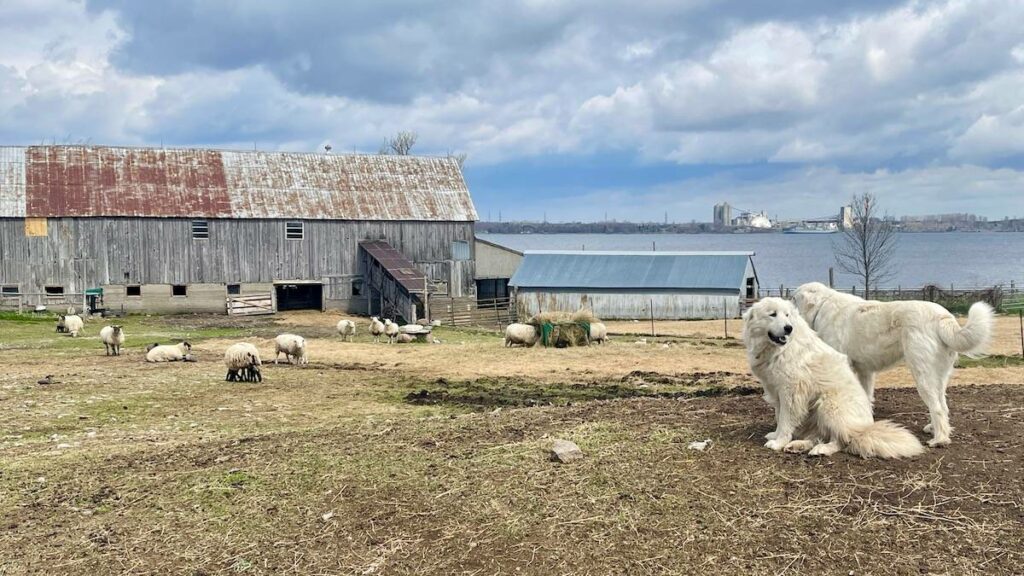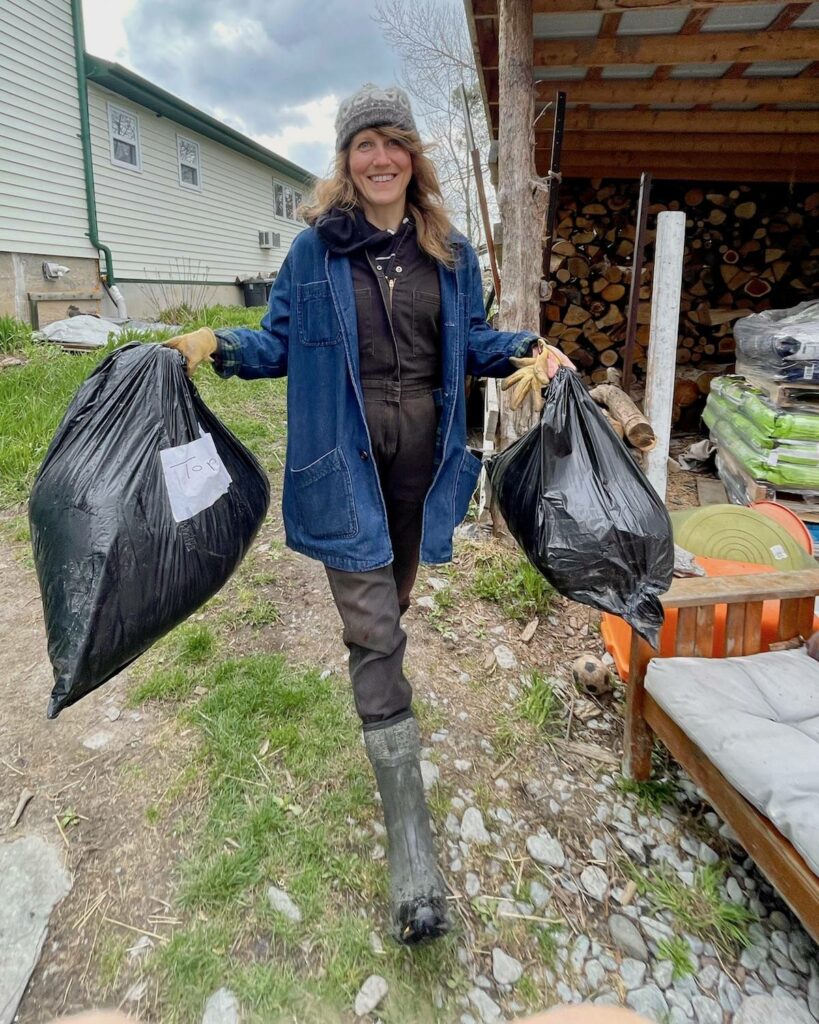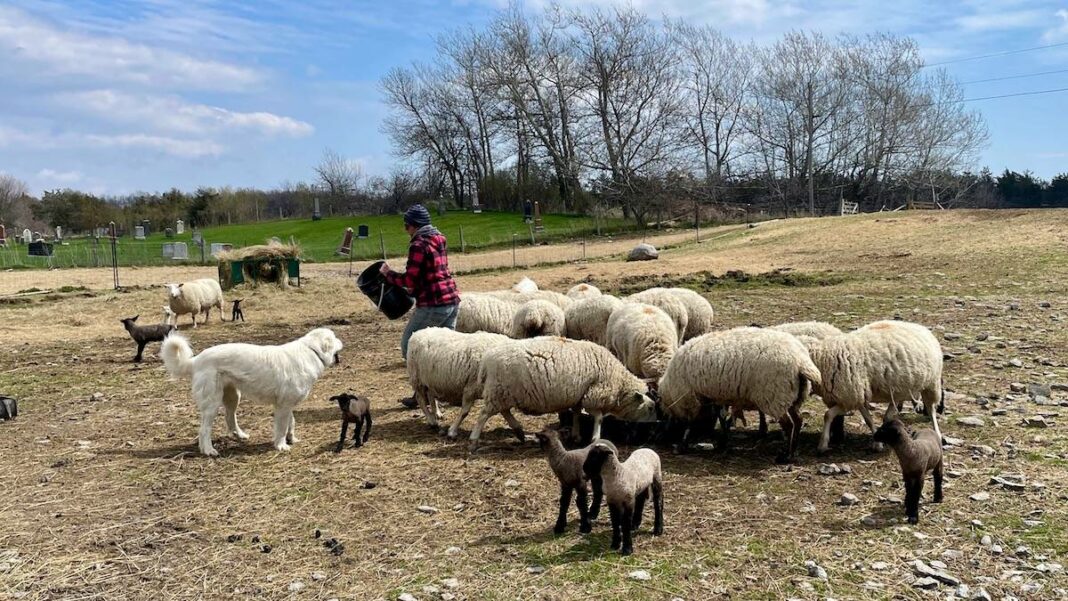An unorthodox but effective non-lethal strategy keeps coyotes at bay — even those hungry for the farm’s sheep.
Some spring mornings, Rachel Hawkshaw and her partner Jake Murray like to get up early, hop on their ATV, and head out into the back forty of Topsy Farms, the sheep farm where they both work. Soaking up the quiet of Amherst Island, the rural oasis at the east end of Lake Ontario where the farm is located, they watch the sunrise through the early-morning mist.
But at least a part of these bucolic jaunts involve keeping watch for a sight they hope they never see: namely, a bloodied carcass of a lamb that somehow strayed from its flock and was ravaged by a hungry coyote.
“When it happens, it tears your heart out,” says Hawkshaw. “We work so hard to keep them safe.”

No one can say how many coyotes inhabit Amherst Island — in winter, they cross the ice of Lake Ontario from the mainland — but they’ve been the bane of Topsy’s shepherds ever since the farm was established as a sort of hippie commune in 1972. To keep the marauders at bay, the farm’s shepherds used to shoot any coyote that threatened the animals, a practice that remains common on other sheep farms. But coyotes are elusive creatures and it’s hard to keep an eye on every corner of a 400-acre property.
In truth, the sheep losses Topsy incurred were more heartbreaking than expensive, as Ontario’s Ministry of Agriculture and Food has a program that compensates farmers for stock lost to predation, provided they can prove they’ve been doing their best to protect their livestock. And Topsy does. The farm has fenced in its pastures and installed electrified wire around the fence at coyote-nose height to discourage coyotes from digging under the barrier in spring when the soil is damp and soft. Solar-powered motion sensors flash powerful white lights at night to scare off nocturnal predators. Perhaps most effective are the farm’s six Pyrenees dogs, some of which are always standing guard near the flock to protect them.

Despite these measures, until Hawkshaw arrived on the scene in 2020 and was handed responsibility for predation control and fence maintenance, Topsy was routinely losing between 40 and 100 sheep per year to canis latrans.
“I figured the definition of insanity is to do the same thing over and over and expect different results,” she says. “I wanted to try something completely different than what we were already doing.”
Rachel Hawkshaw learned of a non-lethal coyote control method that involved spreading human hair and urine along the wire fences. Think of a dog peeing on a fire hydrant to mark its territory, and you get the idea.
Hawkshaw studied environmental sciences at college and wondered if there was a better, non-lethal way to protect the flock, which can range from 400 ewes and rams to as many as 1,200 animals after spring lambing season. After doing some online research and asking around her sheep-farmer network, she caught wind of a coyote control method that involved spreading human hair and human urine along the wire fences. Think of a dog peeing on a fire hydrant to mark its territory, and you get the idea. The technique isn’t novel or unique — farmers in Western Canada, the US, Australia, and elsewhere in Ontario use it — but it was a first for Topsy.
At first, Hawkshaw used a hand-pump sprayer to apply the urine — a product, um, personally donated by the farm’s co-owner, Ian Murray — but now she soaks strips of fabric tied to the page wire fence every 50 feet or so. A local hairdresser donated a few garbage bags of hair, which she scatters in clumps at the base of the fence.


Remarkably, it works. Hawkshaw says sheep predation at Topsy has dropped to around four animals per year.
“We’ve seen good results in the last two years,” she says. “I won’t call it a big success until we have five years of data. That will give us time to monitor the ebb and flow of the seasons and learn about coyote booms and busts. But so far, so good.”
Hawkshaw’s efforts are consistent with the philosophy at Topsy Farms, which is committed to sustainable farming and even posts an animal welfare policy on its website. The policy is focused on the farm’s sheep and Highland cattle, but in practice, it extends it to deer, muskrats, birds, snakes, butterflies, raccoons – and now, even those pesky coyotes.
Hawkshaw’s efforts are consistent with the philosophy at Topsy Farms, which is committed to sustainable farming and even posts an animal welfare policy on its website. The policy is focused on the farm’s sheep and Highland cattle, but in practice, it extends it to deer, muskrats, birds, snakes, butterflies, raccoons – and now, even those pesky coyotes.
Jeff Wiltshire, the resource management coordinator of the Peterborough District office of the Ontario Ministry of Natural Resources, commends Hawkshaw’s initiative. He says some sheep farmers simply want to eliminate coyotes with lethal force, and it’s perfectly legal for them to do so. The province’s Fish and Wildlife Conservation Act contains a provision that allows anyone to shoot or harass a wild animal that’s inflicting damage on their property.

But, as Wiltshire points out, coyotes aren’t all bad: they’re opportunistic and will eat almost anything, including mice, rats, insects, and rabbits, which can also be annoying farm pests.
“What [Topsy Farms] is doing is a great way to coexist with the coyotes,” he says. “If you kill one, there will always be another one to take its place if it knows there’s food around. But if you can keep them away from your livestock and let them feed on other prey, it’s kind of a win-win for the coyote and the farmer.”


